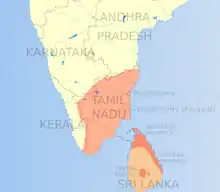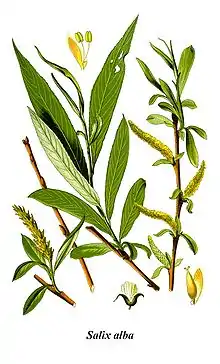Siddha medicine
Siddha medicine is a traditional medicine originating in South India.[1] It is one of the oldest systems of medicine in India.[1][2] The Indian Medical Association regards Siddha medicine degrees as "fake" and Siddha therapies as quackery, posing a danger to national health due to absence of training in science-based medicine.[3][4] Identifying fake medical practitioners without qualifications, the Supreme Court of India stated in 2018 that "unqualified, untrained quacks are posing a great risk to the entire society and playing with the lives of people without having the requisite training and education in the science from approved institutions".[5]
| This article is part of a series on |
| Alternative medicine |
|---|
 |
| Part of a series on |
| Tamils |
|---|
 |
|
|
In rural India, siddhars have learned methods traditionally through master-disciple relationships to become local "healers".[2] Siddhars are among an estimated 400,000 traditional healers practicing medicine in India, comprising some 57% of rural medical care.[3][4] Siddha practitioners believe that five basic elements[6] – earth, water, fire, air, sky – are in food, "humours" of the human body, and herbal, animal or inorganic chemical compounds, such as sulfur and mercury, used as therapies for treating diseases.[7]
The Ministry of Ayurveda, Yoga and Naturopathy, Unani, Siddha and Homoeopathy of the Government of India regulates training in Siddha medicine and other traditional practices grouped collectively as AYUSH.[8] Practitioners are called siddhars (vaithiyars in Tamil), and may have formal training with advanced degrees, such as BSMS (Bachelor in Siddha Medicine and Surgery), MD (Medical Doctor, Siddha) or Doctor of Philosophy (PhD).[9] The Central Council of Indian Medicine, a statutory body established in 1971 under AYUSH, monitors education in areas of rural Indian medicine, including Siddha medicine.[10]
History
Siddha is an ancient Indian traditional treatment system which evolved in South India,[11] and is dated to the times of 3rd millennium BCE Indus Valley Civilization or earlier.[12] According to ancient literature of Siddha, it is said that the system of this medicine originated from Hindu God Shiva who taught it to his consort Parvati. Parvati then passed it on to Nandi and Nandi taught about it to nine Devtas.[13]
Most Siddha medical practitioners are traditionally trained, usually in families and by gurus (teachers). When the guru is a martial arts teacher, he is also known as an ashan. Traditionally, it is taught that the siddhars laid the foundation for this system of medication. Siddhars were spiritual adepts who possessed the ashta siddhis. Nandhisar is considered the first siddha and the guru of all siddhars.
Concept of disease and cause
When the normal equilibrium of the three humors – Vaadham, Pittham and Kapam – is disturbed, disease is caused. The factors assumed to affect this equilibrium are environment, climatic conditions, diet, physical activities, and stress. Under normal conditions, the ratio between Vaadham, Pittham, and Kapam are 4:2:1, respectively.[14]
According to the Siddha medicine system, diet and lifestyle play a major role in health and in curing diseases. This concept of the Siddha medicine is termed as pathiyam and apathiyam, which is essentially a rule based system with a list of "do's and don'ts".
Herbalism
The herbal agents used by the siddhars could be classified into three groups: thavaram (herbal product), thadhu (inorganic substances) and jangamam (animal products).[14] The thadhu agents are further classified as: uppu (water-soluble inorganic substances that give out vapour when put into fire), pashanam (agents not dissolved in water but emit vapour when fired), uparasam (similar to pashanam but differ in action), loham (not dissolved in water but melt when fired), rasam (substances which are soft), and ghandhagam (substances which are insoluble in water, like sulphur).[15]
Siddha today
The Tamil Nadu state runs a 5.5-year course in Siddha medicine (BSMS: Bachelor in Siddha Medicine and Surgery). The Indian Government also gives its focus on Siddha, by starting up medical colleges and research centers like National Institute of Siddha.[16] and Central Council for Research in Siddha.[17] Commercially, Siddha medicine is practiced by siddhars referred in Tamil as vaithiyars.
Regulation
Practicing Siddha medicine and similar forms of rural alternative medicine in India was banned in the Travancore-Cochin Medical Practitioners' Act of 1953,[18] then reinforced in 2018 by the Supreme Court of India which stated that "A number of unqualified, untrained quacks are posing a great risk to the entire society and playing with the lives of people."[5][19] The Act requires that qualified medical practitioners be trained at a recognized institution, and be registered and displayed on a list of valid physician practitioners, as published annually in The Gazette of India.[18] The Gazette list does not recognize practitioners of Siddha medicine because they are not trained, qualified or registered as valid physicians.[3][19][5]
Criticism
Since 2014, the Supreme Court of India and Indian Medical Association have described Siddha medicine as quackery,[3][19][5] and there is no governmental recognition of siddhars as legitimate physicians.[3] The Indian Medical Association regards the Indian institutions that train people in Siddha medicine, the supposed degrees granted, and the graduates of those programs as "fake".[3][5] Since 1953, the Indian national government has not recognized Siddha medicine or any alternative system of medicine as valid, and there is no proposal to integrate Siddha medicine into conventional medicine practiced in India.[3][5]
There may be as many as one million quack "doctors", including siddhars, practicing medicine in the rural regions of India, a condition not actively opposed by the Indian government out of concern for serving some health needs for the large rural population.[3][19][20][4][21] The Indian Medical Association emphatically opposed this position in 2014.[3] In 2018, licensed Indian physicians staged demonstrations and accused the government of sanctioning quackery by proposing to allow rural quacks to practice some aspects of clinical medicine without having complete medical training.[4]
References
- "Siddha medicine". Encyclopedia Britannica. Retrieved 29 November 2020.
- "About Siddha medicine: Origins". National Institute of Siddha. 2020. Retrieved 16 February 2020.
- KK Aggarwal, VN Sharma (2014). "IMA Anti Quackery Wing". Indian Medical Association. Archived from the original on 31 January 2020. Retrieved 28 November 2019.CS1 maint: uses authors parameter (link)
- Michael Safi (2 January 2018). "Indian doctors protest against plan to let 'quacks' practise medicine". The Guardian. Retrieved 28 November 2019.
The government is giving sanction to quackery. If those doctors make mistakes and people pay with their lives, who is going to be held accountable?
- Justice RK Agrawal (13 April 2018). "Judgment by the Supreme Court of India: Kerala Ayurveda Paramparya vs State of Kerala". Supreme Court of India. Archived from the original on 9 December 2019. Retrieved 9 December 2019.
- "Siddha medicine: Basic concepts". Ministry of AYUSH, Government of India. 25 February 2016. Retrieved 16 February 2020.
- "Siddha medicine: Materia medica". Ministry of AYUSH, Government of India. 25 February 2016. Retrieved 16 February 2020.
- "About the Central Council for Research in Ayurvedic Sciences". Central Council for Research in Ayurvedic Sciences, Ministry of AYUSH, Government of India. 2017.
- "Siddha medicine: Courses". National Institute of Siddha. 2020. Retrieved 16 February 2020.
- "Home page of the Central Council of Indian Medicine". Central Council of Indian Medicine. 2008. Retrieved 11 February 2020.
- Boslaugh, Sarah. The SAGE Encyclopedia of Pharmacology and Society. SAGE Publications. p. 2492. ISBN 9781506346182.
- Richard S Weiss (2009). Recipes for Immortality: Healing, Religion, and Community in South India. Oxford University press. p. 95. ISBN 9780195335231.
- S. K. Mukherjee; A. M. Saxena; Gyanesh Shukla; Gian Singh; Dr. T. K. Mukherjee (2002). Progress of diabetes research in India during 20th century. National Institute of Science Communication. p. 100.
- Master Murugan, Chillayah (20 October 2012). "Siddha Therapy, Natural Remedies and Self-Treatment". Varma Kalai. Retrieved 31 May 2013.
- "Herbs used in Siddha medicine for arthritis - A review" (PDF). Indian Journal of Traditional Knowledge. October 2007. Retrieved 10 November 2011.
- "National Institute of Siddha". Chennai, India: NIS, Chennai. Retrieved 25 December 2010.
- "Central Council for Research in Ayurveda & Siddha". India: CCRAS. Retrieved 25 December 2010.
- "Travancore-Cochin Medical Practitioners' Act, 1953" (PDF). Medical Council of Kerala, Kerala Adaptation of Laws. 1956. Retrieved 29 November 2019.
- "Quacks practising medicine great risk to society: Supreme Court". Business Standard. 13 April 2018. Retrieved 28 November 2019.
People having no recognised and approved qualifications, having little knowledge about the indigenous medicines are becoming medical practitioners and playing with the lives of thousands and millions of people. Sometimes such quacks commit blunders and precious lives are lost.
- Sources that criticize AYUSH as a pseudoscience:
- Krishnan, Vidya. "AYUSH Ministry rails against global study on homeopathy". The Hindu. Retrieved 24 May 2017.
- Kumar, Ruchi. "Indian academia is fighting a toxic mix of nationalism and pseudoscience". Quartz India. Retrieved 31 January 2019.
- Steven Novella (3 January 2018). "Indian doctors fight against quackery". Science-Based Medicine. Retrieved 14 September 2019.
